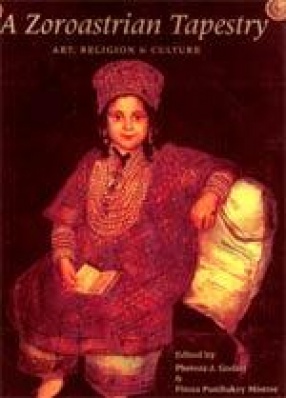The Zoroastrians are the followers of the Iranian Prophet Spitaman Zarathushtra who lived in the great Iranian homeland of Airyanem Vaejah c. 1200 BCE. The Iranians and the Vedic Indians shared a common past and traces of this can be gleaned from the Avesta and Rig Veda. The Zoroastrain people entered recorded history in 550 BCE and for over a thousand years their religion flourished as the imperial religion of three great Iranian empires; the Achaemenians, Parthians, and Sasanians. During this period, Zoroastrianism was a dominant religion and its religious beliefs influenced Judaism, Christianity, and later, Islam. The vast extent of their empire brought the Zoroastrians in contact with people of different races and traditions. Their willingness to absorb and adapt these influences led them to develop a district art form, as evident in the city palaces of Pasargadae and Persepolis and in the rock carvings of Naqsh-I Rustam, Bishapur, and Taq-I Bustan. The only major upheaval during this period was brought about by the invasion in the fourth century BCE of Alexander of Macedon who, against all odds, emerged victorious over the Achaemenian armies. In the aftermath of Alexander's death a fragmented empire gave way to a resurgent Zoroastrian force, the Parthians. During their rule, sacred fires of the faith were established and the Zoroastrian sacred text the Avesta was compiled under royal patronage. The Sasanians, who succeeded the Parthians in the third century CE, played a significant role as many of the religious rites and traditions followed by the Zoroastrians today can be traced to the Sasanian attempt to consolidate and unify the faith. Zoroastrian dominance in the Near East came to an end with the Arab conquest of Iran in the seventh century CE. The subsequent spread of Islam in Iran forced the community to live in obscurity and isolation in the remote desert province of Yazd, as well as in other regions of Iran such as Kerman where they zealously safeguarded their ancient religion, kept the sacred fires burning, and preserved their culture. In the tenth century CE A SMALL GROUP OF Zoroastrians originally from the province of Khorasan landed on the western coast of India and were given sanctuary by the Hindu king, Jadi Rana. Over time the Parsis, as they came to be known, settled in tiny enclaves along the western coast of India. They migrated to Bombay in the seventeenth century at the invitation of the East India Company. In Bombay the community prospered as ship builders, cotton kings, and international traders and brokers. Endowments and educational institutions were established and in time Parsis became the agents of social change. Known for their integrity and loyalty, they have left an indelible imprint on the culture and social ethos of India. This lavishly illustrated volume attempts to span a vast period of time and gives a glimpse of the life and times of the Zoroastrian people in Iran and India as manifested in their art, religion, and culture.
A Zoroastrian Tapestry: Art, Religion & Culture
Out of stock
Out of stock
Free & Quick Delivery Worldwide
Bibliographic information
Title
A Zoroastrian Tapestry: Art, Religion & Culture
Author
Edition
1st ed.
Publisher
ISBN
9781890206222
Length
762p., Col. & B/w Plates; Figures; Maps; Glossary; Bibliography; Index; 34cm.
Subjects









There are no reviews yet.